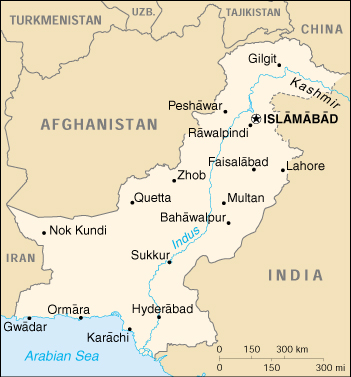

Status Quo Side: India
Non-Status Quo Side: Pakistan
Region: South Asia & SW Asia
Conflict Type: Interstate
Issues in Dispute: Territory
After their inconclusive 1947-49 war over Kashmir [see KAS], both parties had accepted the principle of a plebescite there. Pakistan felt threatened by India's post-1962 arms buildup after confronting China over borders [see ICB], particularly when India withdrew its plebescite commitment. Following incidents along the UN-monitored "line of control" in early 1965 and armed skirmishes in the Rann of Kutch, India alleged Pakistani mobilization and ordered a military alert. A de facto cease fire in April was formalized on June 30. India later accepted arbitration and a larger UN observer force. Anti-Indian unrest in Kashmir grew.
Pakistan infiltrated disguised troops into Kashmir to foment revolt, unsuccessfully. India crossed the cease-fire line to halt further raiders. Pakistan on September 1 attacked in Jammu to cut Indian communications. India responded September 6-8 with full-scale attacks in three sectors of West Pakistan. UNSC calls for a cease-fire, backed by US and UK arms cut-offs and a Chinese ultimatum, were successful.
Truce violations and failure to withdraw triggered five UNSC appeals. A Soviet-sponsored agreement at Tashkent on January 10 1966 brought about a mutual force reduction in Kashmir.
Despite the Simla Agreement of 1972 specifying peaceful resolution of outstanding issues, signed after the war over Bangladesh in 1971 [see BAN], and renewed diplomatic ties in 1976, relations deteriorated over nuclear and arms aid issues. A December 1985 summit reached agreement not to bomb each other's nuclear facilities, but the Indian offer of a no-war pact was withdrawn in 1986 when Pakistan failed to promise not to raise the Kashmir plebescite issue in world fora. By year's end 340,000 troops were lined along the frontier. On February 21, 1987 both agreed to a 70% withdrawal. In July 1988 Muslim militants in Kashmir began a violent campaign protesting economic, political and ethnic grievances.
By January 1990 the upsurge in separatist fervor prompted India to resume direct rule and to threaten war to punish Pakistan for aiding the insurgents. Border clashes increased. On July 4 1991 the parties signed military security agreements aimed at preventing another war. But four years later the crisis had been revived by a split in the insurgency between those seeking independence and those seeking union with Pakistan under Islamic rule; by a parallel rise in Hindu extremism; and by the flow of weaponry left over from the Afghanistan conflict [see AFG]. In May, 1997 the two prime ministers met in the Maldive Islands and agreed to put the past behind them, and agreed the following month in Islamabad to hold talks on Kashmir. The situation changed dramatically with installation in 1996 in India of a coalition containing the radical nationalist BJP party. In May 1998 India conducted tests of five nuclear devices, followed in a few days by Pakistani nuclear weapons tests. Both were roundly condemned internationally and sanctions imposed.
In February, 1999 Indian Prime Minister Atal Bigari Vajpayee made an extraordinary bus trip to meet Pakistan leader Nawaz Sharif, both pledging to reduce tensions. But on May 26, 1999 more than 600 Kashmiri militants (allegedly including some Afghans) who India claimed were backed by Islamabad, made a major incursion across the Line of Control into the Kargil region of Indian-held Kashmir. India responded with air strikes and recovered the territory.
With sporadic skirmishes and an estimated 600,000 Indian and 150,000 Pakistani troops in the region, the newly-strained relations were overhung with the specter of nuclear escalation.